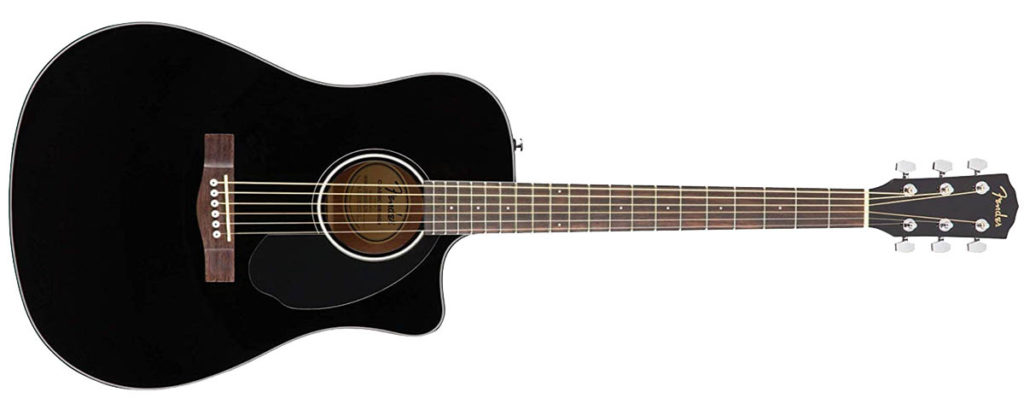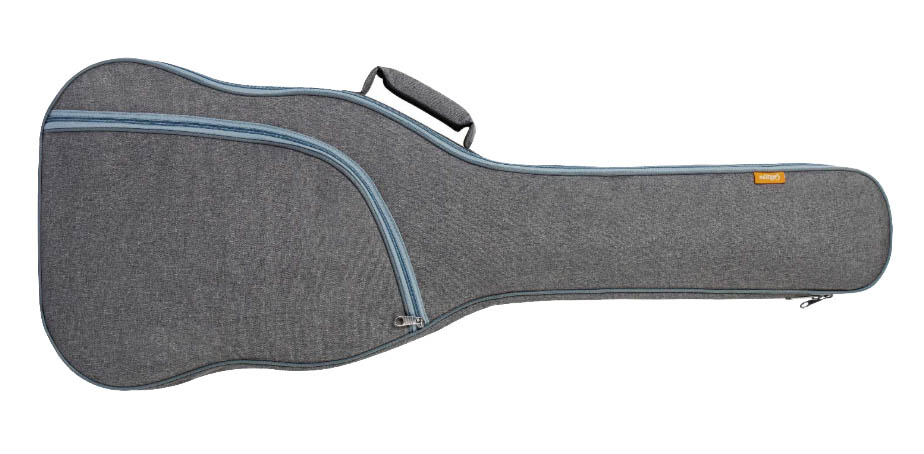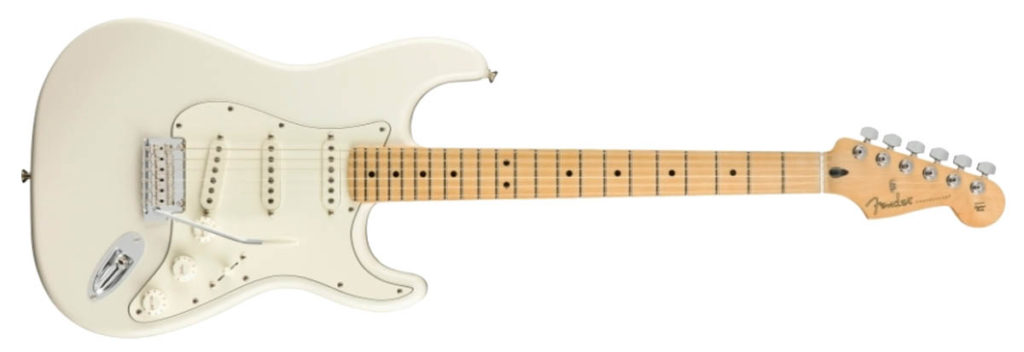Fender is an American guitar manufacturer who has been making guitars and other instruments since they started in 1946. Many people recognize the Fender name, and think of them when looking for a beginner guitar.
“But which one should I get?”, you say. “There are so many. Are they all good? Are some better for beginners than others?” Continue reading for my top 2 acoustic and top 2 electric Fender guitar recommendations for beginners.
Before I go any further, here are the Fender guitars I recommend for beginners in this article.
Acoustic: Fender CD-60S
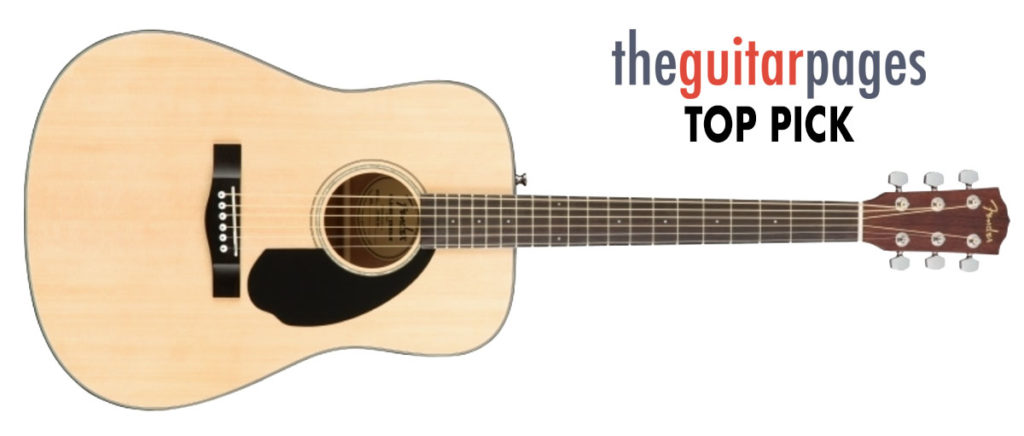
Fender CD-60S Solid Spruce Top Acoustic, Amazon
The Fender CD-60S series guitars feature the classic dreadnought body style, a solid spruce top, and a hardshell case.
The solid top is complemented with a laminated back and side material that maximizes durability while still maintaining the increased sound quality of the solid piece of spruce used for the top of the guitar. For more info about solid vs laminate tops on acoustic guitars I wrote all about that here.
Both the CD-60S, and the more expensive cutaway version with built in electronics the CD-60SCE come with a hardshell case option. I highly recommend getting it with the hardshell case. It is well worth it, and will protect the guitar much more than a flimsy gigbag.
Electric: Squier Affinity Stratocaster
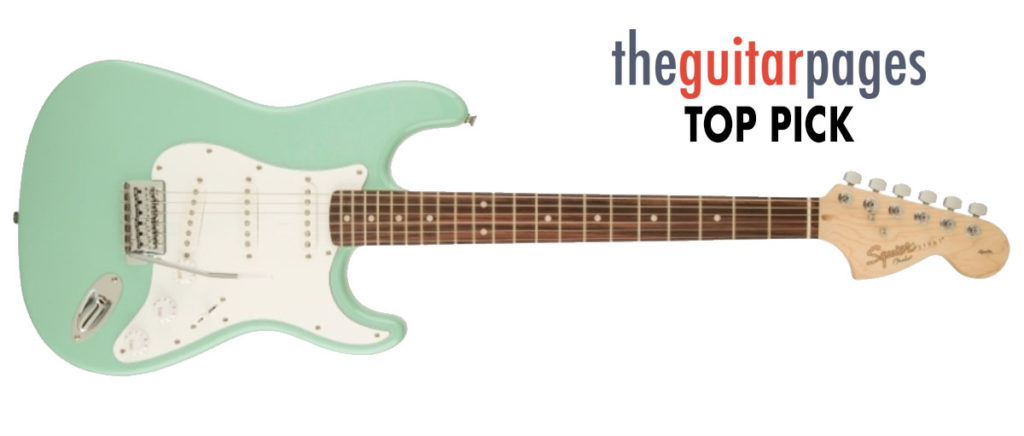
Squier Affinity Stratocaster, Amazon
The Squier Affinity Series Strat makes for a great first electric guitar. This is a step up from their cheapest line of guitars and offers higher quality components, materials, and are easier to set up correctly. But isn’t Squier just a cheap Fender copy? Read below for the answer on that.
I think this is the perfect electric guitar for beginner guitar player. These have all the great strat tones that are familiar to us from decades of rock music.
The Fender Standard Series is the first entry into the Fender line, and is a major step up. These are phenomenal guitars that would last someone their entire guitar playing career. I’ve played Fender Standard Strats that have felt and sounded better than American made ones. These are made in their Mexico factory along with most of their tube amplifiers.
What is Squier and are they any good?
Squier is a subsidiary brand under the Fender Musical Instrument Corporation. Squier originated as an instrument and string manufacturer that Fender bought back in the 1960s. Fender reused the name for their entry level instruments. While most Squier guitars are now made in China and Indonesia, in the past they have been produced in Mexico, Japan, Korea, and the United States.
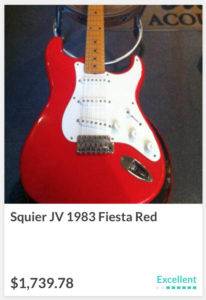
Vintage Squiers were remarkably well built, and can easily fetch over $1500 on the used market. Contrast that with my 1979 American made Fender Mustang still in its original case that would have a hard time selling for more than $1300.
But the question is really, Are new Squiers any good? Yes, Squier’s quality control is very impressive, spitting out consistent guitars that sound great. For a beginner, a Squier electric is a great option and will last many years.
Wait, you said electrics but what about Squier acoustics? Are they any good?
You’ll notice I have left Squier acoustics off this list and gone straight to the Fender brand for the best acoustic guitar for a beginner. Maybe this is just my experience, but I have never found a Squier acoustic that didn’t require a significant amount of work before it was even close to playable.
Oftentimes I’d have to perform a ton of fretwork in order for notes to not choke out and everything to sound like it should. Skip the Squier acoustic and get the Fender. The lower price tag can be tempting, but a guitar like that is more frustrating to play and is often the reason for beginners quitting.
One thing I’ve noticed is that their lower priced instruments need a bit of setup work before they feel and sound their best. For example, it was quite common to see guitars from the Squier Affinity and Bullet series arrive needing a bit of fret dressing.
Definition: Fret Dressing
Fret Dressing is the last step of fret work when the manufacturer, or luthier, files the fret ends flush to the fingerboard and rounds any sharp corners. This makes a guitar’s fretboard feel smooth and easy to play.
Should A Beginner Start on an Acoustic or Electric?
I explore this question in more depth in my post on How to Buy the Best Beginner Guitar. An acoustic guitar may be initially more difficult to get the notes to come through correctly, but teaches better technique, and develops finger strength and control quicker. I personally recommend a beginning guitar play start on an acoustic.
However, the single most important thing is providing an instrument that will be fun and exciting. That makes an electric guitar particularly interesting to most young players. Electric guitar packages can be affordable and a ton of fun to experiment with different sounds.
If you’re concerned about yourself, or your kid, getting bored, then go with an electric. If that’s not an issue, then go with an acoustic guitar.
Best Beginner Fender Acoustic: CD-60S
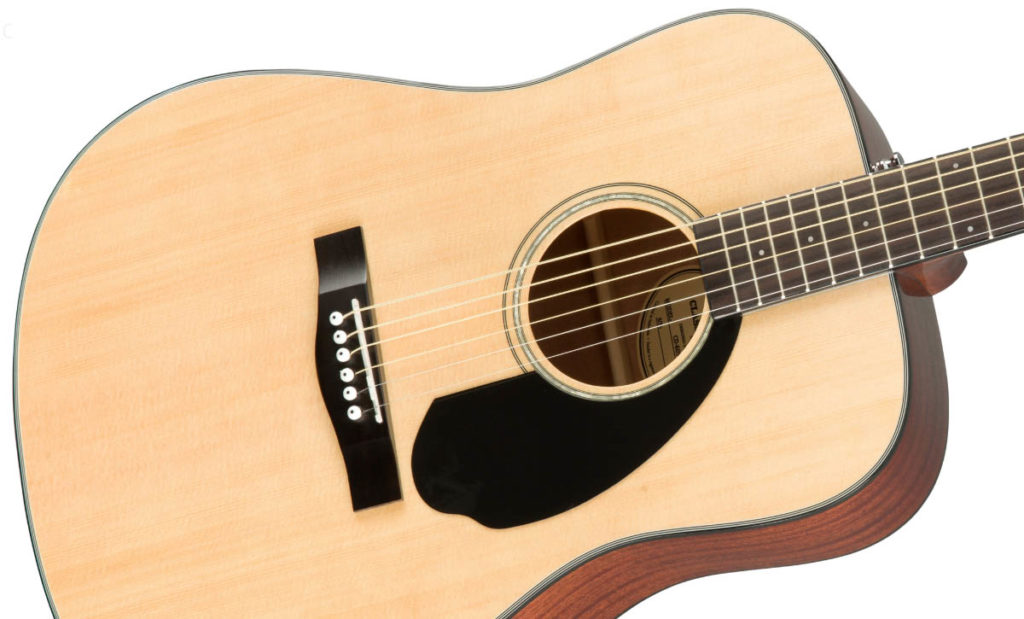
Fender CD-60S Solid Spruce Top Acoustic, Amazon
The Fender CD-60S is the perfect acoustic guitar for a beginner. It has a classic dreadnought shape which sounds great and gives you a very traditional acoustic guitar sound. While a dreadnought may look a little on the big side next to some young players, I have found that most who are 12 years old and older have no problem reaching all of the notes. Also, a 12 year old will quickly grow into the full size guitar if they are right on the edge.
The “S” in CD-60S stands for Solid Top. This means that the guitar has a solid spruce top. Check out my post about the difference between solid top and laminate top guitars. The back and sides are a laminate material which maximizes the sound quality of the solid spruce top while providing durability to both getting bumped and knocked around, and also changes in humidity and temperature.
Speaking of humidity and temperature, because the CD-60S has a solid piece of wood for the top, or soundboard, it’s incredibly important to humidify the guitar correctly. If a guitar’s top wood dries out too much it can crack, which is expensive to repair. Read my article about humidity and proper care for your acoustic guitar.
I have set up and played hundreds of these guitars. The quality is always very good and these can make incredibly playable guitars.
The CD-60S is perfect for any acoustic style of music, and will last for a long time. There are packages available where this guitar is sold with a gig bag instead of the hardshell case. Do not go with this option. As of the writing of this article the gig bag option is only $20 cheaper than the hardshell. The hardshell case is worth way more than $20, and getting it along with the guitar in the package listed above is a great deal.
I see a CD-60 option, should I get that? The CD-60, as opposed to the CD-60S, is the same guitar, but with a laminated top. Again, read more about this distinction here, but the difference is only $20 and it is well worth the small increase to go with the solid top option. Do not buy the CD-60, go with the CD-60S.
What is the CD-60SCE?
As you can see, the CD-60SCE looks slightly different. This is called a cutaway, as the lower bout of the guitar has been “cut away” to allow easier access to the upper frets.
Another feature of a cutaway guitar is that almost always it will also have electronics built into it. What does “electronics built into it” mean? Electronics in an acoustic contain a mic, a transducer, or both which captures the sound produced by the guitar, amplifies it and allows you to plug the guitar into an amplifier to play louder, play with a band, or play in live settings where amplification is necessary.
Oftentimes, electronics like these will also contain a built-in tuner which can be quite handy, and which the CD-60SCE does offer.
In terms of acoustic sound, an acoustic cutaway will generally not have as much overall sound.
Is the Fender CD-60SCE cutaway version with the electronics a good guitar for beginners?
There are some potential downsides of having electronics built into the guitar. For one, they run off of 9v batteries, and the guitar needs to be unplugged every time after playing it or else the battery will go dead. This can cause you to burn through batteries pretty fast if, say, you have a kid who has a hard time remembering to do that.
Tuners contained in guitar electronics can be hit or miss. For the most part they work pretty well, but clip on tuners are incredibly affordable and much more accurate. I’m a huge fan of clip-on tuners and use them on all of my guitars. There are a ton of them out there, but here’s my list of my favorite 5 clip on tuners.
For young players, there’s a middle ground to be found between the ‘cool’ factor, and minimizing distractions. Extra features on any piece of equipment should only be there if they are necessary, not because you get more ‘bang for your buck.’
In my opinion, unless you plan to plug the guitar into an amp, it’s best to minimize distractions and get the standard acoustic.
Should I Get the Fender Acoustic With the Gig Bag, or the Hardshell Case?
For an in-depth look at guitar cases, check out my main article on the subject, The Ultimate Guide to Guitar Cases.
As mentioned above, you should look for the package that includes the hardshell case instead of the gig bag, but why is that?
Gig bags have a couple advantages, they are light and easy to carry. And… that’s about it. When most younger players carry a guitar, it looks like the case is full of wild squirrels covered in hot sauce. Or remember that scene in Christmas Vacation?

And that’s the danger of a gig bag. They don’t have the protection necessary to mitigate impact damage to an instrument. A heavy book dropped on the top of a guitar that’s in a gig bag could do some serious damage where that same guitar in a hardshell case would not see a scratch.
The tradeoff is that a hardshell case is going to be a bit heavier. But in my opinion it’s completely worth it. Plus it’ll develop some good arm strength, and who doesn’t want that?
The hardshell case package is also a great deal. As of the time of writing, the hardshell package was only $20 more than the gig bag package. For reference, this is a similar hardshell case that sells for right around $75.
Going with this option out of the gate will save you some money up front, and protect your new guitar as best as possible.
Next Best Fender Acoustic – Tim Armstrong Hellcat
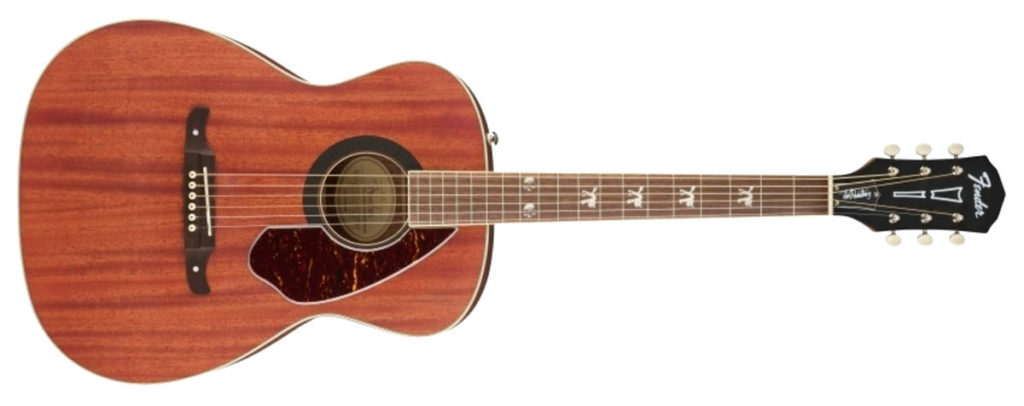
Fender Tim Armstrong Hellcat Solid Mahogany Top Acoustic, Amazon
My next favorite Fender acoustic guitar is the Tim Armstrong artist model acoustic guitar. It features a solid mahogany top with plied back and sides much like the CD-60 above. This gives the best of both worlds: the tone of a solid top, with the strength and consistency of plied material for the back and sides (the parts which impact the overall sound the least).
This guitar is one of the seemingly rare acoustics that retain the full body shape (no cutaway of the lower bout) while also including the classic Fender electronics, allowing you to plug the guitar into an amp or PA system.
I love the look and feel of this guitar. Most younger players, and Tim Armstrong fans do as well.
The solid mahogany top will have a little bit of a darker tone than the brightness of the CD-60’s solid spruce top. This “darkness”, however, rounds out the bright frequencies and tends to be nice and mellow, with a warm boost in the midrange.
This guitar does not come with a case, but this hardshell over at Guitar Center is built from Fender specifically for the Tim Armstrong model.
Satin Finish
This guitar features a beautiful satin finish. I really like satin finishes because they don’t get all smudged up with fingerprints as easily as glossy finishes, and they look great in all light. A satin finish also will hide nicks, and scratches a little bit better which will come in handy as your guitar becomes battle tested.
Low Action
The Tim Armstrong acoustic features a great neck that is incredibly easy to play. The back of the neck features the same satin finish as the body of the guitar, which feels great on the hands and doesn’t get a tacky feeling that a glossy finish can get.
It is made of maple, which makes it one of the only Fender acoustics with a maple neck, and I really love how that looks against the dark mahogany body.
Body Shape
You’ll notice that the body shape of the Hellcat is a bit different than that of the CD-60S. The CD-60 is what’s called a dreadnought. This is by far the most common acoustic guitar shape, and results in a great sound with a large, warm tone.
The Hellcat is what’s called a concert body guitar. This means that while the lower and upper bouts of the guitar remain in the same place, the waist is pulled in which softens the curves of the overall guitar. The forward shoulders of the guitar (forward upper and lower bouts) pull in slightly to round out the overall shape.
The body size of a concert remains big enough to reproduce great quality tone, but the skinnier waist makes this guitar sit on the lap very nicely. Smaller players tend to prefer this concert body shape over a traditional dreadnought.
Hellcat Inlays
One of the defining characteristics of this guitar is the inlay work on the fretboard. These may be the coolest inlays that are on any acoustic currently. The arched back hellcat adorns the 3rd, 5th, 7th, and 9th frets while a pair of skulls sit on the 12th. In terms of coolness, it doesn’t get much better than this.
Hopefully this will influence a younger generation to check out the music of foundational rockers like Tim Armstrong, and his bands Operation Ivy and Rancid.
Pickguard
The other visual element that jumps out immediately is the irregular pickguard. This is a 4 ply tortoiseshell pickguard with a unique shape. Personally, I think the shape complements the guitar perfectly, and the ply is a nice touch that harkens to instruments of a much higher price tag.
Best Beginner Fender Electric: Squier Affinity Stratocaster
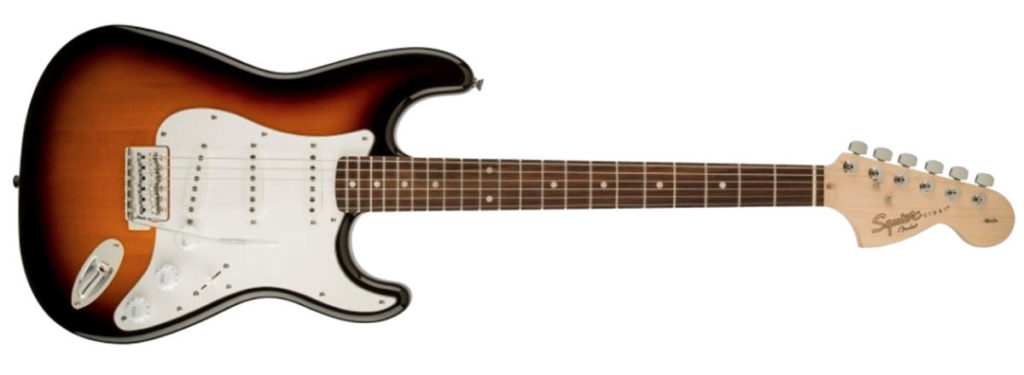
Squier Affinity Stratocaster Brown Sunburst, Amazon
As noted above, the Squier line is reserved for Fender’s entry level instruments. While I stay away from Squier acoustics, their electric guitars are incredibly consistent, refined, and reliable. These are the perfect electric guitars for beginners.
The Stratocaster is an iconic guitar, maybe the most recognized electric guitar in rock history. It first debuted in 1954, and has been manufactured continuously since. It’s hard to imagine a day when the Strat will no longer be actively built. Thankfully we don’t have to worry too much as it is still one of the most produced guitar shapes today.
This is not only an iconic guitar, but is a great platform for a new player to get the hang of the electric guitar.
Is the Strat a Good Guitar for Beginners?
The Stratocaster can be intimidating at first, with switches, knobs, and a whammy bar, but with the challenges the Strat presents it is a great guitar for beginners.
Electronics
The Strat’s controls feature a pickup selector switch, 1 volume knob, and 2 tone knobs. These are easy to learn and get the hang of, and while this does offer quite a few options for finding the tone you like, a couple minutes of tinkering and you’ll find your favorite sound.
There are three pickups in the standard Strat configuration, which are all single coil pickups as opposed to humbucker pickups.
How to tell the difference between a humbucker and a single coil? Generally, a humbucker will be two times wider than a single coil pickup, which makes sense because a humbucking pickup is simply two single coils wired in series which helps cancel out transient noise induced by things like powerful fluorescent lighting.
When referring to pickup configurations on guitars, you’ll see something like a SSS Strat or SHS Strat, etc. This simple means SSS = (single coil, single coil, single coil). And SHS = (single coil, humbucker, single coil). This terminology is used for all guitars and configurations, not just strats.
Speaking of the electronics selector, most modern strats feature a 5 position switch. Positions 1,3,5 select each three pickups by themselves starting with the pickup closest to the neck of the guitar.
Positions 2 and 4 put the neck and middle, neck and bridge pickups together respectively and have an awesome tone that I love to use for rhythm playing and Hendrix like chording. Again, this puts the pickups together in a way that eliminates most loud hum, which is a great trick to know. Positions 2 and 4 on a Strat are the quietest for excess noise.
Like I mentioned, while the 4 controls on a Strat can be a bit intimidating at first (how do you manage to not always hit the volume knob!? Answer: it just takes time to get used to it) spending a bit of time playing around with the different tones and settings will yield a configuration that you really like.
Body and Shape
The contoured body of the Strat fits comfortably on the lap if you’re sitting down, or against the body if you are standing up.
The Strat body features what is called a double cutaway, or double cut for short. This means that the upper and lower shoulders of the guitar body are “cut away” to provide easy access to the upper frets. And of course it looks cool too.
Strats are generally pretty light as well, coming in at between 7 – 8 lbs (3 – 4kg). This will really save your back during long sessions, and makes a great guitar for younger players. For comparison, the Gibson Les Paul is 9 – 12 pounds (4.1kg – 5.4kg). Those extra couple of pounds can make a huge difference when playing for long stretches of time.
Neck
Modern Strat necks are made with the player in mind. By that I mean they have found a great middle ground for a thin neck with great playability. If a neck is too thin, it may be considered good for shred style playing, or playing super fast which isn’t ideal for new players. If a neck is too chunky it might be really comfortable for playing open chords, but unwieldy when it comes to lead playing.
The Squier Affinity Strat has a great neck that features a satin finish. Like with the Tim Armstrong acoustic mentioned above, a satin neck on a guitar has a smooth feel and doesn’t get a tacky or gummy texture if your hands start to sweat a bit, or if it’s just humid where you live.
Colors
The Squier Affinity series is one of the brand’s legacy lines, and is often getting updated and refreshed year after year. While the fundemental aspects of the guitars remain the same, Fender often adds new colors to their lineup. Currently, the Affinity comes in the old classic black and sunbursts, and also some super cool colors like Surf Green, and Competition Orange.
What about the Whammy?
The only thing about the Strat that can be a hurdle for newer players is the whammy bar. This is also called a Tremelo, or trem for short. Fortunately, the Squier Strats come with the tremolo “decked” or tightened all the way down. This makes the guitar much more stable and won’t be as frustrating for a beginner.
** Fun Fact, the effect that a tremolo, or whammy bar makes is actually vibrato. Tremolo is the increase and decrease of volume while vibrato is the modulation of the pitch of a note up and down. The tremolo on a guitar works by loosening the strings, then returning to the originally position and pitch. This provides a wavering effect. Why do we call it tremolo if it’s really vibrato? In 1954 when Fender released the Stratocaster, it was billed as having a “synchronyzed tremolo system.” And according to Fender, “Indeed, one of the very first Strat advertisements in 1954 led with the headline Tremolo Action.” [https://www.fender.com/articles/tech-talk/pitch-or-volume-the-difference-between-tremolo-and-vibrato] **
If you want the tremolo setup more like a normal strat with the floating trem, just take your guitar to a competent guitar tech or guitar shop and they’ll be able to do a setup on a guitar pretty quickly and easily to get it exactly how you want it.
Do I Need An Amplifier to Play Your Squier Affinity Strat?
While there are ways to play electric guitar without an amplifier, like this affordable headphone amp. I highly recommend getting a good beginner amp. This will make playing an electric so much more fun and honestly makes all the difference when you’re first starting out.
Check out my main article on the best beginner amps where I break it down between cool features and ease of use. There is a great, affordable amp for every player out there.
When starting out on guitar, it’s important to be able to hear the notes clearly in order to know if you’re pressing the strings correctly. Playing without an amp early on can actually reinforce some bad technique simply because you can’t hear the mistakes that are being made.
Most modern amplifiers (like the ones I talk about in the article above) are chock full of awesome sounding amp models and cool effects that will keep any new player excited about the sounds they are learning to make.
Most also can connect to a computer in order to record directly into a recording program. This opens up a whole world that many players are also getting into. A high percentage of guitar players also do an amount of home recording and music production. This is a great way to dip your toes into that world.
Getting a Case for the Squier Affinity Strat
The Affinity Strats do not come with a case or gig bag. I know I was pretty opposed to gig bags above when talking about the acoustic guitars, but here’s the thing. Acoustic guitars need a lot more care and protection because they are inherently more fragile instrument. The solid body, and solid neck connection of an electric make gig bags for electric guitars a great, and affordable option.
My suggestion for a good Strat gig bag would be the CAHAYA Electric Guitar Padded Gig Bag. This is a great gig bag with plenty of padding, backpack straps for easy hauling, and a large pocket big enough to hold your sheet music, picks, capos, instrument cable, etc.
If you want to go with a hardshell case, go with the ABS Fender molded case. These are the strongest, most robust cases. The latches on these things are basically indestructible and the case will nearly outlast whatever guitar you put in it. I have one of these for my 15 year old Fender Strat, and I would never use another case for it. It is pretty pricey which makes the gig bag a much more reasonable solution. But if you want a truly great case that will last forever, go with the ABS molded cases.
Best Quality Beginner Fender Electric Guitar: Fender Player Series
Fender Player Series Stratocaster in Polar White, Amazon
If you want to get your first true Fender electric guitar, with the squiggly Fender logo on the headstock, start by looking at the Fender Player Series Strat. This is an amazingly well made guitar with high quality pickups, electronics, and other components that truly elevate this guitar to the next level.
What is the next level you ask? Anything above this you make sure that you’re getting an American made guitar. This is the last price range in which you get a guitar that is imported.
The Fender Player Series, amongst others, is made in Fender’s Mexico factory. The Mexican Fender factory started in 1987 and has producing amazing guitars, amps, and components ever since. In fact, the factory over in Ensenada, Baja Mexico is less than 200 miles from where all of the high end American made Fender products are made in Corona, California.

If you’re not new to this, you may recognize the Player series as the introductory Fender guitar that used to be called the Standard series (as opposed to the American Standard for the introductory American guitars). But these are not a direct swap for the Standard line, things have been upgraded a bit.
Pickups
One of the biggest changes, tonally speaking, that was made to this series was the pickups. Fender went from a ceramic pickup to an Alnico pickup.
What does that mean for us? Ceramic pickups have higher output and are generally described as being “hotter.”
Alnico has slightly reduced highs and a nice boost in the midrange which gives the pickup a warm, balanced tone that sounds great with the chimeyness of a single coil pickup.
All the classic Strats that we’ve heard on countless records all used Alnico pickups and as soon as you play a guitar with that sound you’ll recognize it immediately. This is a massive upgrade and a welcome one. For a guitar that’s less than $700, having Alnico pickups really sets it into that next tier of quality.
Bridge
The next biggest upgrade that was made to this guitar line was the bridge. It went from an old style 6 point system to a modern synchronized 2 point bridge.
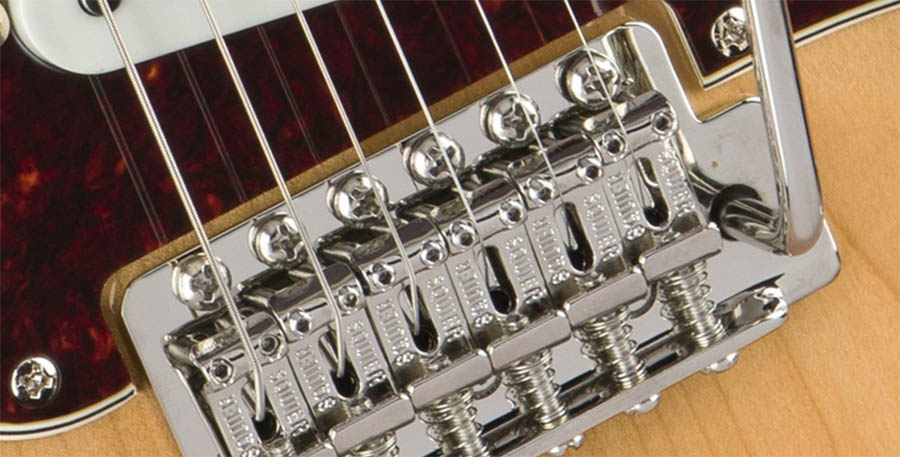
One of the major issues that comes up with the old style bridge is binding of the trem movement. It takes a bit of work to get one setup evenly and playing with a smooth action. Even then, under certain tensions one side of the bridge can actuate differently than the other causing some weird movement. This isn’t a deal breaker, as many vintage Strats used this system. However the modern 2 point Trem is a huge upgrade.
With 2 points acting as the fulcrum, the Tremolo moves freely and easily without binding. This creates a nice dreamy whammy effect that can sounds more like the controlled modulations of a Bigsby rather than something with far less mass.
Of course if you’re starting out and would rather not have to deal with the Tremolo moving around you can always have a competent tech “deck” the bridge for you in the same way that the Squier Affinity comes from the factory. This can be a great decision for early players as it helps stabilize the strings while learning chording and the various pressures needed.
** Beginner Tip **
When first starting out, beginner guitar players struggle with how hard to press the strings. This is a tactile skill that only comes with continued practice. Moving from an acoustic to an electric guitar, like quite a few players do, can lead to frustrations where the player needs to relearn how hard to press the strings.
An electric guitar requires less pressure on the strings to fret the notes correctly because of the smaller string gauges. If you press the strings on an electric guitar with the same amount of pressure that you use for your acoustic, all your notes are going to go sharp.
If the strings are pressed down hard, a Tremolo can also move around causing the note to change pitch again. This additional tug of war with the tremolo occurs by design, and means that it is working properly. However, it can take some time to learn the feel required to play a guitar with a floating bridge correctly. Decking the bridge as a beginner is a great way to get around this and allows the player to work up to the fully floating configuration.
A light touch needs to be developed in order to accurately and efficiently play notes and chords on an electric guitar.
I find that it’s much easier, however, to go from an acoustic guitar to an electric as the hand and finger strength has already been developed and it’s the touch that just needs to be worked on.
Cosmetic
There were a couple small cosmetic changes made to the Player series Strats. These were the addition of an F Neckplate, and the old style “spaghetti” Fender logo.
Typically, made in Mexico Strats have a blank neck plate and Fender reserves the “Fender” or “F” plates for American made lines. The upgrades made to this guitar were enough for them to slap an engraved neck plate on this one. Plus I think it looks pretty cool.
The Fender “spaghetti” logo refers to a specific version of the Fender logo that was used in the 50s and early 60s on the original Strats and other Fender guitars and amps. This is a small change, but a cool throwback that levels the guitar up and let’s this Strat sit at the big kids’ table.
Case
Sadly, the Player series guitars do not come with cases. Frankly, the cases that came with the Standard series before were very lightweight gig bags that did little to protect a persons new, beautiful investment.
Most purchase a hardshell case, and I suggest the ABS molded Fender case which is the one that comes with the American made Stratocasters. Sure, this case is a little expensive, but it’s completely worth it in mind. A good case can save you hundreds of dollars in repair fees, and is great insurance for your brand new guitar.
Conclusion
My absolute favorite and top pick for someone looking for their first guitar, and especially their first Fender. The Fender CD-60S sounds great, is built like a tank, and is incredibly affordable. Don’t waste your time with cheaper acoustics that will cause you pain and trouble. Buy this one, be done with it, and go learn how to play guitar.
For the player who’s either a huge Rancid fan, or wants something with a bit more character. The Tim Armstrong Hellcat acoustic is super high quality, and sounds just as awesome as it looks. This guitar is a tier up from the CD-60S and an awesome beginner Fender acoustic.
It’s amazing to me that you can buy such a high quality guitar for so little money. These Squier’s constantly surprise me with how well they play and sound. For a first Fender electric guitar you absolutely cannot go wrong with a Squier Affinity Strat. Just make sure to pick up a great amp while you’re at it.
For the guitar player who wants something of high quality without spending their life savings. The Player Series Strat from Fender gives you top tier quality and components for a much lower price. These guitars are truly impressive and will not need to be upgraded because of the instrument holding you back. (You’ll just buy another guitar because you will eventually catch the bug and the collection will start to grow. Don’t fight it, it happens to the best of us.)
I hope you found this guide to the best Fender guitars for beginners helpful, and please let me know if I missed a Fender guitar that you think would be great for a first time player. Until next time, geez stop reading this already and go pick up your guitar.

